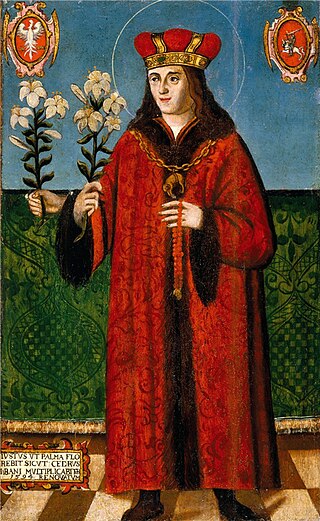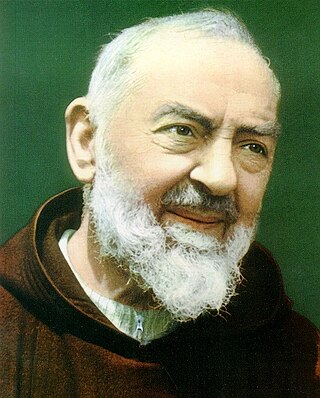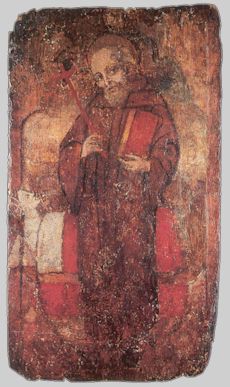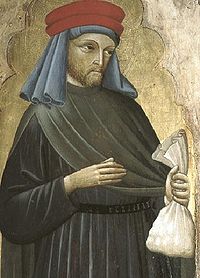
Casimir Jagiellon was a prince of the Kingdom of Poland and of the Grand Duchy of Lithuania. The second son of King Casimir IV Jagiellon, he was tutored by Johannes Longinus, a Polish chronicler and diplomat. After his elder brother Vladislaus was elected as King of Bohemia in 1471, Casimir became the heir apparent. At the age of 13, Casimir participated in the failed military campaign to install him as King of Hungary. He became known for his piety, devotion to God, and generosity towards the sick and poor. He became ill and died at the age of 25. He was buried in Vilnius Cathedral. His canonization was initiated by his brother King Sigismund I the Old in 1514 and the tradition holds that he was canonized in 1521.

Anthony of Padua, OFM or Anthony of Lisbon was a Portuguese Catholic priest and friar of the Franciscan Order.

Cremona is a city and comune in northern Italy, situated in Lombardy, on the left bank of the Po river in the middle of the Pianura Padana. It is the capital of the province of Cremona and the seat of the local city and province governments. The city of Cremona is especially noted for its musical history and traditions, including some of the earliest and most renowned luthiers, such as Giuseppe Guarneri, Antonio Stradivari, Francesco Rugeri, Vincenzo Rugeri, and several members of the Amati family.

Pio of Pietrelcina, widely known as Padre Pio, was an Italian Capuchin friar, priest, stigmatist, and mystic. He is venerated as a saint in the Catholic Church, celebrated on 23 September.

Nicholas of Tolentino, , known as the Patron of Holy Souls, was an Italian saint and mystic. He is particularly invoked as an advocate for the souls in Purgatory, especially during Lent and the month of November. In many Augustinian churches, there are weekly devotions to St. Nicholas on behalf of the suffering souls. November 2, All Souls' Day, holds special significance for the devotees of St. Nicholas of Tolentino.

Anthony Maria Zaccaria, CRSP was an early leader of the Counter Reformation, the founder of religious orders (Barnabites) and a promoter of the devotion to the Passion of Christ, the Eucharist and the renewal of the religious life among the laity. He is venerated as a saint in the Catholic Church, which celebrates his feast day on 5 July.

Gaetano dei Conti di Thiene, known as Saint Cajetan, was an Italian Catholic priest and religious reformer, co-founder of the Theatines. He is recognised as a saint in the Catholic Church, and his feast day is 7 August.

Gotthard, also known as Gothard or Godehard the Bishop, was a German bishop venerated as a saint.

Gerard Majella was an Italian lay brother of the Congregation of the Redeemer, better known as the Redemptorists, who is honored as a saint by the Catholic Church.

Pacificus of San Severino, born Carlo Antonio Divini, was an Italian Roman Catholic priest known for being a miracle-worker.

Joseph Cafasso was an Italian Catholic priest who was a significant social reformer in Turin. He was one of the so-called "Social Saints" who emerged during that particular era. He is known as the "Priest of the Gallows" due to his extensive work with those prisoners who were condemned to death. But he was also known for his excessive mortifications despite his frail constitution: he neglected certain foods and conditions to remain as frugal and basic as possible unless a doctor ordered otherwise.

Sant'Omobono is a church in Rome at the foot of the Capitoline Hill in rione Ripa.

Philip Benizi was a general superior of the Order of the Servites, and credited with reviving the order. Pope Leo X recognised his cult 24 January 1516 essentially beatifying him ; and Pope Clement X canonized him as a saint in 1671.

Silvestro Guzzolini was an Italian Catholic priest and the founder of the Silvestrini. He served as a canon in Osimo but respectful rebukes of his bishop's inappropriate conduct led him to leave for a hermitage before the bishop could strip him of his position. He remained in his hermitage with a determination to found a religious congregation and based it upon the Order of Saint Benedict after having a dream of Benedict of Nursia. His order received papal approval from Pope Innocent IV which allowed his order to expand across Italian cities to a significant degree.

Peter of Capua was an Italian scholastic theologian and prelate. He served as cardinal-deacon of Santa Maria in Via Lata from 1193 until 1201 and cardinal-priest of San Marcello al Corso from 1201 until his death. He often worked as a papal legate. He wrote several theological works and was a patron of his hometown of Amalfi.

Blessed Hemming of Turku was a Swedish Roman Catholic bishop and served as the Bishop of Turku from 1338 until 1366. He was born in Sweden though relocated to Finland following his appointment as bishop. He became a popular figure in the diocese for his staunch dedication to the educational and spiritual needs of the faithful. He was also a close friend of Saint Bridget of Sweden. During his studies he knew the future Pope Clement VI as one of his classmates.

Chiara Offreduccio, known as Clare of Assisi, was an Italian saint who was one of the first followers of Francis of Assisi.

Vigilius of Trent is venerated as the patron saint and bishop of Trent. He should not be confused with the pope of the same name.
Sant'Omobono is a Roman Catholic church located on the piazzetta di Sant'Omobono, in central Cremona, region of Lombardy, Italy. The church faces across the piazza, the Palazzo Pallavicino and Palazzo Cattaneo. The piazza was formerly a cemetery used during time of the plague.


















